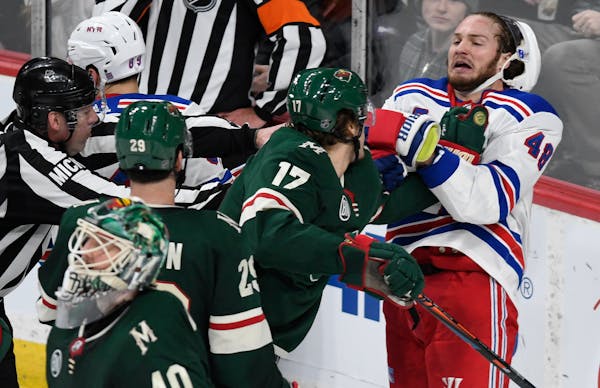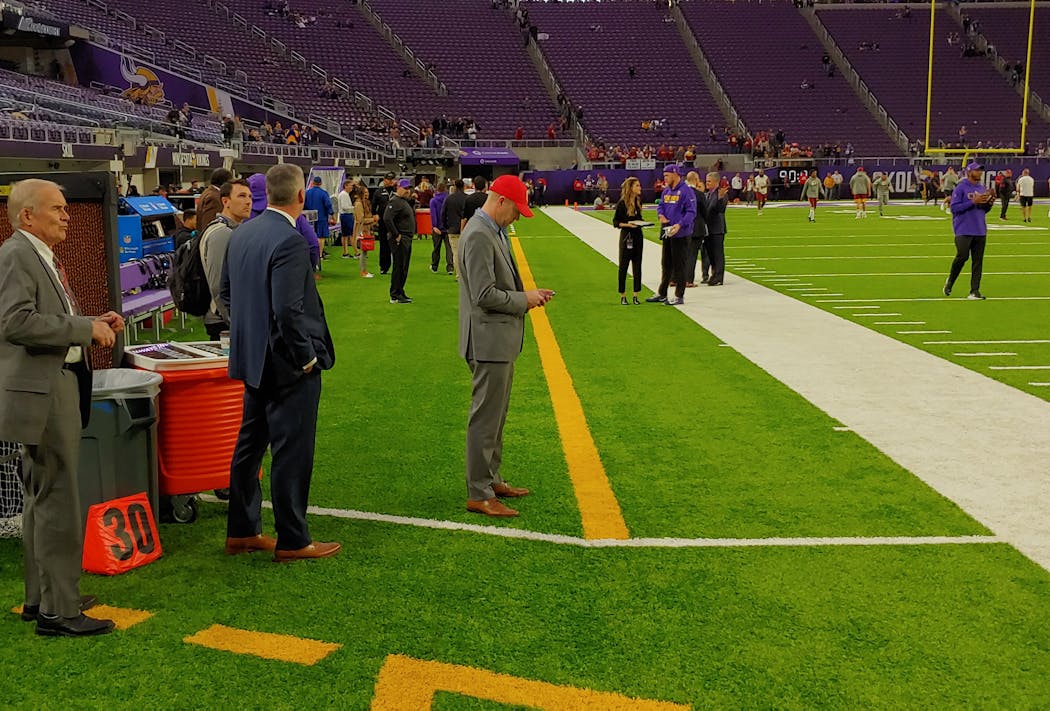Who are all the people on sidelines during Vikings games?
Listen and subscribe to our podcast: Via Apple Podcasts | Spotify | Stitcher
In his younger days, retired U.S. Postal Service worker Al Nedohon of Anoka was also a juggler who performed with his troupe at halftime of a Detroit Lions-Minnesota Vikings game at the Metrodome.
That performance meant the guys got to stand on the 5-yard line to watch the rest of the game. Nedohon recalled the ground "thundering" as Lions' running back Barry Sanders rumbled out of bounds, narrowly missing some of his gang. "He would have clobbered us," Nedohon recalled.
Nedohon, 70, is retired from juggling now, but he keeps an eye on the Vikings sidelines and wants to know who all the people are on the sidelines. "You've got a coach for every player. ... Who are all these people?" Nedohon brought his question to Curious Minnesota, our community-driven reporting project fueled by questions from readers.
Accounting for the full perimeter of the field during a home game, there are roughly 300 people with their feet on the turf. None of them are down there for fun. Players, coaches, doctors, trainers, media, referees and layers of security roam the sidelines.
But team personnel mostly stand within a box that is defined by a solid yellow line parallel to the field and dotted yellow lines on the three other sides. The team contingent is expected to stay mainly within that box but are allowed some leeway.
Anybody in the box is working; there are no spectators.
On game day, the Vikings have 46 players suited up in white and purple. Seven deactivated players on the roster are in the box but not in uniform.
The Vikings have about two dozen coaches. Nine of them will be upstairs and communicating with the field coaches through headsets.
Of the coaches on the field, two of them can communicate directly with a single player on the field — one on defense and one on offense. Head coach Mike Zimmer usually speaks directly to defensive player Anthony Barr. Offensive coordinator Kevin Stefanski is in the ear of quarterback Kirk Cousins. Attached to each coach is a technician who sticks by their side to keep the lines to the field working.
The players can hear the coaches, but have no microphone so they can't talk back to them. Per the rules, the connection gets turned off as the play clock ticks down.
So when Cousins is making a frantic circular motion with a hand while looking to the sideline — he's signaling to Stefanski that he needs the play call repeated because he didn't catch it the first time.
A member of the team's communications staff is on the field and relays injury information to the press box.
The team's three strength coaches — who help the players stretch before games — become "get-back guys" during the game. They monitor the players to keep them from wandering past the sideline and onto the field, which would cause a penalty. The get-back gang also makes sure players are far enough back that they don't block a referee's movement or get blindsided when players blast past the sidelines.
The team's on-field medical presence, led by vice president Eric Sugarman, is extensive and specialized: There are three orthopedic surgeons in the box along with three family practice doctors, one physician focused on airways, three emergency medical technicians and three chiropractors. There are six team athletic trainers.
Per NFL rules, there is also an unaffiliated neurological consultant to monitor for concussions.
One of the team's top two security coordinators will be in the box.
Generally, the team owners, the Wilfs, are up in their luxury private suite on the 50-yard line just shy of midway up the seating bowl.
Toward the end of the games, the sideline crowds can swell. More members of the communications staff will join the team to help players navigate postgame interviews. For a big game, Zygi Wilf might head down to the field.
Beyond the sacrosanct team boxes, the entire field is lined with media and security from both U.S. Bank Stadium and the Minneapolis Police. At the game against the Washington Redskins, there were 30 still photographers credentialed from media outlets. The Star Tribune had four photographers — one in each corner. (Print reporters watch the games from the up in the press box.)
Before the game, the field is much more accessible. Some 1,500 fans, friends and family get on the field and it's a fun way to feel out the turf and see the players warming up. Wide receiver Stefon Diggs is especially playful and personable when he's not running drills.
---
If you'd like to submit a Curious Minnesota question, fill out the form below:
Read more Curious Minnesota stories:
Why are Honeycrisp apples still so expensive?
Why is it so much harder for U students to graduate debt free compared with the 1960s?
How did Minnesota become one of the most racially inequitable states?
What is the best place, time to see northern lights in Minnesota?
Why does everyone love to hate Edina?
Sorry, but why do Minnesotans say 'ope' all the time?
How did these 11 Minnesota towns get their unusual names?
Has Minnesota every had a major earthquake?
How did the Twin Cities become a hub for Somali immigrants?
Why is Uptown south of downtown in Minneapolis?




